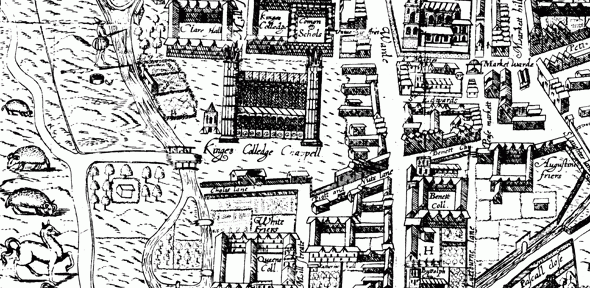Clik here to view.

The earliest complete map of Cambridge, dated 1574, is held by the British Museum: it is too frail to be displayed. Drawn in exquisite detail, it shows the intermingling of the Colleges – then variously described as Halls, Ostells, Colledges and Howses– with the town itself complete with yardes, greenes and cawseys (causeways). The soaring shape of King’s Collegde Chappell is instantly recognisable. To its west, a lone fisherman stands beside the river, rod in hand. He wears a conical hat, doublet and hose, and pointy shoes. Horses frolic in the meadows of Newnam and pigs rootle in Swinecrofte.
A copy of this wonderful map will be on display for talks and tours of the Cambridgeshire Collection taking place on 13 and 14 September as part of the Open Cambridge programme. Chris Jakes, Local Studies Manager for Cambridgeshire Libraries, will use the1574 map as well as other items from the Collection to show how much can be learnt from this unique archive.
The introduction to the Collection on the top floor of the Central Library will include a tour of the store in the basement of the Library. Here more than 4.4 million images, 25,000 maps, many hundreds of books and journals, as well as ephemeral items such as handbills and posters, are housed in a fire-proof chamber. These documents are used by scholars in a wide range of disciplines as well as members of the public, particularly those researching family histories.
The thousands of historic illustrations held by the Cambridgeshire Collection include engravings by David Loggan (1634-1692) whose fabulous bird’s eye views of the Cambridge Colleges are masterpieces of draftsmanship. Loggan’s engraving of Trinity College shows a small garden and a shed-like building just outside the College walls. Analysis of the soil at this spot reveals significant traces of mercury, strongly suggesting that it was in this hut that Isaac Newton carried out some of his experiments.
Another treasure to be on show is a copy of the Cambridge Chronicle, dated 24 August 1776, which reprints in full the American Declaration of Independence. The paper, which covers London as well as local news, offers a window into another world – some 70 years before the railway arrived in Cambridge. Few regional papers were produced in this era; thus the Cambridge Chronicle was also sold in York and other places on the Great North Road. Twice-weekly issues of the paper were printed on Market Hill and would have travelled north by stage coach.
Reports of births, deaths and marriages of the well-to-do are followed by news of grisly murders and executions. A tea smuggler has escaped from the prison at Cambridge Castle, having broken through the roof. Surprisingly, he says he will return to pay his bill for food. A bay mare has disappeared, or been stolen from, Skellingsthorpe Fen in Lincolnshire. Farms are up for sale in the Cambridgeshire villages of Little Stukely[sic] and Upwell. An advertisement for “antiscorbutic drops” promises to cure a dizzying array of ailments and is supported by a glowing endorsement from a customer who wrote that the holes in her feet had been healed.
The Cambridgeshire Collection boasts the earliest known tourist guide to Oxford and Cambridge. The title page reads The Foreigner’s Companion through the Universities of Cambridge and Oxford and the author is given as Mr Salmon. It was printed in 1748 for William Owen, at Homer’s Head, near Temple Bar, in Fleet Street, London. One section is devoted to famous people listed by College and another to the exotic plants to be spotted in the college gardens. In the ensuing years, before the advent of copyright, Salmon’s guide was plagiarised by other publishers who brazenly lifted whole sections of his text.
Image may be NSFW.
Clik here to view.
To reserve a place for this event, and many others, go to www.cam.ac.uk/opencambridge 01223 766766. Many pre-book events quickly reach capacity but others are run on a drop-in basis. For opening times of the Cambridgeshire Collection go to http://www.cambridgeshire.gov.uk/leisure/archives/local_history/cambs/
For more information on this story contact Alex Buxton, Office of Communications, University of Cambridge amb206@admin.cam.ac.uk 01223 761673
A map dating from 1574 describes Cambridge as a very famous city. A copy of this exquisite document is one of the many thousands of treasures contained in the Cambridgeshire Collection. Chris Jakes, Local Studies Manager for Cambridgeshire Libraries, will give an introduction to a unique archive as part of Open Cambridge (13-15 September).
Image may be NSFW.
Clik here to view.
This work is licensed under a Creative Commons Licence. If you use this content on your site please link back to this page.